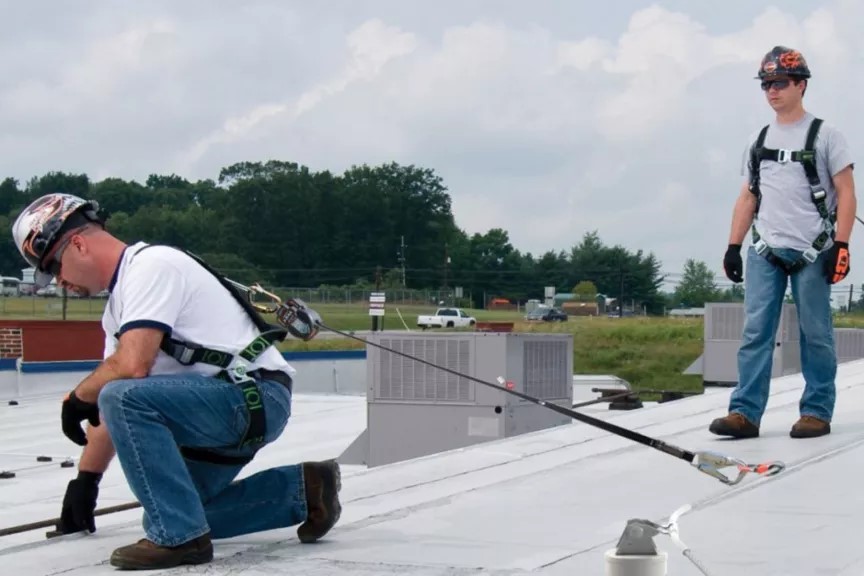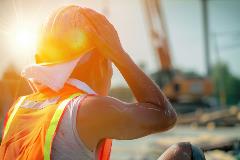Key Considerations When Selecting PPE For Warm Weather

Whether they’re working indoor or outdoor, workers who are exposed to excessive heat and doing strenuous work are at risk of heat stress. If their body is not able to regulate the internal temperature fast enough, this could lead to heat-related illnesses such as heat exhaustion or heat stroke.
Another risk when workers are doing physical tasks in a hot and/or humid environment is that they may want to get comfortable by taking off layers, which can also lead to cutting corners in safety.
Heat Stress Impact
 In the last four decades, the United States has warmed faster, at an average rate of 0.31 to 0.54°F per decade. As the temperature increases, so does the likelihood of heat-related illness in industries operating in hot and humid conditions, like bakeries, commercial kitchens, chemical plants, mines, and also in outdoor operations such as construction or farming. To add to the heat stress, many of these workplaces require that workers wear PPE.
In the last four decades, the United States has warmed faster, at an average rate of 0.31 to 0.54°F per decade. As the temperature increases, so does the likelihood of heat-related illness in industries operating in hot and humid conditions, like bakeries, commercial kitchens, chemical plants, mines, and also in outdoor operations such as construction or farming. To add to the heat stress, many of these workplaces require that workers wear PPE.
Exposure to environmental heat led to 37 work-related deaths (33 of which occurred in the summer months of June through September) and 2,830 nonfatal occupational injuries and illnesses involving days away from work in 2015, according to the Bureau of Labor Statistics.
Preventing heat stress in workers is important, as excessive exposure to heat can affect
worker health, safety, and productivity. It’s the employers’ responsibility to provide awareness training to workers so that they understand how heat stress affects their health and safety, and how it can be prevented.
Heat stress can lead to illnesses ranging from sunburn to heatstroke. The Centers for Disease Control details some of the most important warning signs and symptoms:
Heat Cramps:
 Prolonged sweating
Prolonged sweating - Muscle pain or cramps
Heat Exhaustion:
- Heavy sweating
- Cold, pale, and clammy skin
- Fast, weak pulse
- Nausea or vomiting
- Muscle cramps
- Tiredness or weakness
- Dizziness
- Headache
Heatstroke:
- High body temperature
- Confusion
- Fainting
- Convulsions
- Hot, red, dry, or damp skin
- Fast, strong pulse
- Fainting
Experts Recommend That:
- Physically intensive tasks are not performed in the heat of the day
- Water breaks should be frequent, to minimize dehydration
- Sun exposure should be limited
- PPE clothing is light and comfortable
- Employees should be given time to acclimate
What to Keep in Mind When Considering PPE Especially Designed for the Warm Months
Jana Bacinska, Advanced User Experience Designer at Honeywell, shares her considerations for employers looking into PPE for warmer weather for their crews.
The choice of PPE very much depends on the region. Each region has its own specifics; high humidity makes it feel even hotter than it actually is. In regions where the climate is warm most of the year, people are also more used to dealing with it. In regions with mild climates, where heat waves hit just for a couple of months or less, employers are not inclined to invest into special equipment just for a short period of time.
 “It could be very dangerous to underestimate the hot weather health hazards workers face during the summer months and employers should take it seriously”, says the Honeywell expert, adding that “if the company wants to make sure that the workers are comfortable during the summer and most importantly that they are safe, it should definitely consider investing in PPE specifically designed for the summer, since it requires quite a different approach from the design perspective, as well as the material selection”.
“It could be very dangerous to underestimate the hot weather health hazards workers face during the summer months and employers should take it seriously”, says the Honeywell expert, adding that “if the company wants to make sure that the workers are comfortable during the summer and most importantly that they are safe, it should definitely consider investing in PPE specifically designed for the summer, since it requires quite a different approach from the design perspective, as well as the material selection”.
What employers should keep in mind when thinking about PPE for warm weather are the challenges that workers face when working in hot environments.
On the one hand, it’s how the body reacts to the heat. If the internal body temperature rises with the ambient temperature, then the body starts to cool down itself, trying to cool down the brain and internal organs so they can function properly. The veins in the body are getting wider, to allow the blood flow to transfer the heat from the inside of the body to the skin and then to the pores to produce sweat. As the sweat evaporates, it makes us cool down.
On the other hand, PPE is usually considered an extra layer and during the summer period, this is something that can become even more uncomfortable. Workers tend to feel that it's restricting them and may feel inclined to take it off or just avoid wearing PPE altogether. “And there is always the problem of compliance”, says Bacinska.
Since in Honeywell we are very well aware of this problem, we are trying to make PPE lightweight and breathable. As PPE is something that workers are often wearing on top of everything else, says Bacinska, Honeywell is focusing on making it as lightweight and breathable as possible, to increase comfort for the wearer and compliance level on job sites.
Since the main purpose of PPE is to be protective, in regard to the standards that workers need to comply with, traditionally stiffer and more resistant materials are being used. But this can make PPE heavier and not that comfortable and breathable. Bacinska says that “when we are developing new products, we are trying to eliminate as much weight as possible, and still keep the protection level and the outstanding performance. But we are trying to make it comfortable so that it doesn't restrict the user and encourages the user to keep the PPE on at all times, thus helping to promote workers safety (or/and compliance)”.
Connect with Saf-T-Gard to Learn More
By adopting simple and affordable measures, employers can create comfortable and cool work environments for their teams. Industrial safety is our legacy going back 9 decades. For an overview of our Honeywell PPE products, including eye protection, hand and arm protection, head protection, professional footwear, fall protection, and to order for immediate shipment, please visit Honeywell.

